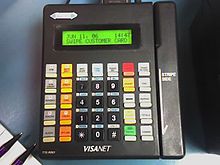- Credit card terminal
-
A Credit card terminal is a device that can do transactions with a debit card or a credit card. Several types of credit card terminals are available to merchants. Most have the same basic purpose and functions. They allow a merchant to swipe or key in required credit card information and transmit such data to the merchant service provider. Most newer models processes credit cards, gift cards, and are expandable to perform check verification. The majority of credit card terminals transmit data over a standard telephone line or the internet. Wireless terminals can transmit card data using either cellular networks or satellite networks. Some also have the ability to store data and transmit over a standard telephone line when one becomes available.
Using a smartphone and the appropriate software, a merchant can replace the functionality of a dedicated hardware credit card terminal using a credit card terminal app running on their smartphone. These credit card terminal apps support manual entry of the credit card number. The apps may work with hardware devices known as swipers or credit card readers to transfer the credit card track data to the app. An app which is capable of reading the credit card track data will help the merchant receive a better discount rate on their credit card processing costs.
Key functionality of a Credit Card Terminal.
The credit card terminal of today has multiple facets. Depending on the needs of the merchant and the type of transactions processed by the card issuing bank, key operations and functions include:[1]
- Acceptance of credit, debit and charge cards (both domestic and international)
- Key Entry (mail and telephone order)
- Tips
- Refunds and Adjustments
- Settlement (including Automatic)
- Pre-Authorisation
- Remote Initialisation and Software update
- POS Integration
- Multi-merchant Capabilities
- Pen or PIN
- Surcharge Function
- Secure Password Operation
See also
References
Credit, charge, and debit cards Major credit cards Major debit cards Charge cards Regional cards BC Card · Carte Bleue · China UnionPay · Dankort · Discover · Girocard (EC) · Interac · Laser · RuPay · V PAYDefunct cards Accounts Interest Payment Technology Automated teller machine · EMV · Smart card · Contactless payment · Interbank network · Credit card terminal · Magnetic stripe cardSecurity/crime Categories:- Merchant services
- Credit card terminology
Wikimedia Foundation. 2010.

